A crucial component of kindergarten instruction, collective teaching activities are a good way to educate young children on their overall development. The language field is one of the subjects taught in kindergarten, and it has to do with how kids learn to read, write, and speak. In order to improve teachers’ comprehension of children’s emotional reactions and language, this paper combines quantitative and qualitative methods to observe and analyze the quality of current language collective teaching activities in kindergartens. It also suggests knowledge logic and psychological logic for grasping the content of language collective teaching in kindergartens. To improve the quality of language teaching in kindergartens, it is crucial to adopt a variety of teaching strategies and organizational techniques, provide the proper tools and materials for language learning, pay attention to the key experiences of children learning the language, and enhance learning quality.
Early childhood education has steadily risen to the top of the educational priorities as education in our nation has developed. Therefore, stronger standards are proposed for the quality of preschool teachers; teachers should not only have the ability to organize educational activities but also possess good language expression skills. While early student education is highly regarded by the state, the speech behavior of preschool teachers serves as both a tool for carrying out activity planning for the kids and a significant source of language input for them. Effective language input is a crucial component in ensuring that children acquire language, and the effectiveness of language education and teaching in children is strongly impacted by teachers’ speech behavior during language education activities.
Language education for children is one of the five areas of kindergarten instruction that is relatively challenging. It intersects all five areas of early student education, and its effects can be seen in other areas at any time. Although children’s language development, language expression skills, comprehension, and feedback on teachers’ teaching materials can all be developed in any field of teaching activities, the field of language education ultimately holds the responsibility for fostering young children’s language development in the most direct way possible. The purpose of early language education is to increase children’s capacity to speak Mandarin with perfect pronunciation while also enhancing their vocabulary to foster the development of their thinking and oral expression skills. The positive habit of listening to and being able to tell stories lays the basis for further language skill development in primary school. In my own postgraduate educational practice, I discovered that different kindergarten teachers organize language-learning activities for the kids differently when observing their own teaching activities as well as the teaching activities of other kindergarten teachers. The degree of instruction that is accomplished varies greatly.
For adults, the primary function of language is to facilitate thought and communication; for young children, the situation is different. The early years of life are crucial for a child’s language development. Language is the primary tool used by children to learn about and comprehend the outside world. Children need language to grasp the outside world, and as a result, language has two functions for kids: it helps them learn things and also serves as a tool for learning. In addition, instructors’ direction is essential for children’s language development. However, how do teachers’ speech patterns affect their students when participating in language learning activities? What impact do various teachers have on interactions between teachers and students? What are the influencing factors on the teaching and learning of languages to youngsters? What exactly are the effective factors? What methods can be used to encourage teachers to speak effectively during activities involving language learning in children? This paper aims to clear up these doubts in the practical process by utilizing activities for teaching youngsters language, studying middle school teachers’ speaking patterns.
The initial focus of foreign research on classroom evaluation was classroom effectiveness, with the goal of raising the quality of instruction in the classroom. To improve classroom teaching quality, foster teachers’ professional development, and ultimately accomplish the goal of promoting student learning, it is necessary to examine what constitutes good teacher performance in the classroom, observe teachers’ teaching behavior, judge teachers’ success or failure, and find reasons for problems found in classroom teaching.
Researchers studying classroom instruction hold the opinion that “effective teaching” depends on two factors: first, defining what constitutes “effective teaching” in a classroom, or, more specifically, what is meant by a high-quality classroom, and second, figuring out how to accomplish both [1,2]. It was suggested that four principles be used to create standards for the effectiveness of teachers’ classroom evaluations: the principle of teaching unity, the principle of objectivity and credibility, the principle of operability, and the principle of stability [3, 4]. Consider teaching evaluation to be a crucial component of classroom instruction that influences the effectiveness of instruction.
He emphasized that the primary issues with today’s evaluation of classroom instruction in kindergartens are the one-sided evaluation content, the use of just one evaluation method, the use of general language, and the formalization of children as the subject of evaluation [5, 6]. Consider that different areas and types of kindergartens have varying levels of instructional processes. Many teachers lack teaching touch, and there is a tendency in certain rural gardens where teachers control time mechanically [7, 8].
Some recommendations are made in response to issues with the current evaluation of kindergarten teaching. The following are the key ones: Kindergarten teachers should evaluate students holistically, taking into account their knowledge, abilities, and emotions in addition to their knowledge mastery [9, 10]. Evaluation techniques should be applied in a flexible and varied manner. Teachers ought to evaluate students primarily using qualitative evaluation techniques. Children should be evaluated by teachers using a variety of criteria, including expressive evaluation and motivational evaluation techniques. Additionally, evaluations must be precise, pertinent, and focused.
More than 100 papers about English education have been found in recent years by searching the CNKI database, Baidu Academic, and other databases [11, 12]. It is discovered that the material already written on English education primarily focuses on the following issues: Mandarin education. While there is very little research on classroom evaluation standards for language activities in kindergartens, there is a lot of research on the effectiveness of language activities, the goals and contents, methods and principles, design and organization of language education, and problems and countermeasures in language activities, etc. There is hardly any meaningful research on the standards for evaluating kindergarten classrooms, according to the effectiveness of instruction to judge the classroom.
There are many issues with current English interaction, including target deviation from language interaction, difficulty of teaching content above children’s developmental level, and low teacher content control [13, 14]. Despite the interest of the activity link, the activity target lacks some directionality. In terms of activity content, activity objective, and activity method, recommendations and countermeasures for improving teachers’ language proficiency and instructional abilities are made [15, 16].
It is not difficult to discover from current classroom evaluation research that evaluation has changed somewhat from the previous perspective of over-evaluating teaching and under-evaluating learning to a focus on both teachers’ teaching and students’ learning, including students as the main body [17, 18]. Evaluation techniques are evolving along with the evaluation criteria used in the classroom. Standardized tests and absolute evaluations were once the norm, but today formative evaluation techniques are encouraged, and research on teachers’ evaluation language is receiving more and more attention in an effort to improve teachers’ evaluation literacy in the classroom and raise the standard of classroom instruction [19, 20].
Research on kindergarten classroom evaluation is becoming less and less systematic, and its connotative research content, which largely focuses on its issues and methods, is lacking [21, 22]. Both theoretical and exploratory parts of the linked research on English schooling are present. However, there is little empirical research on language teaching in kindergarten, there are few studies, and the scientific rigor of the studies has to be confirmed [23, 24].
The design and organization of diverse language education activities continue to receive the majority of attention in current practical research on language activities in kindergartens, but language classroom observation techniques have received little attention. The inquiry yields nearly nothing [25]. Therefore, it is a viable technique to investigate how to monitor and assess English classroom activities in order to further create English educational activities and further enhance the professional quality of teachers.
Review the basic features of the CLASS evaluation tool briefly before discussing the situation in English classes: the tool has eleven sub-dimensions and three major dimensions. It can be broken down into three levels using a 7-point scale, with the low level being 1-2 points, the medium level being 3-5 points, and the high level being 6-7 points; there are three major dimensions and ten minor dimensions as depicted in Figure 1:

Three categories can be used to categorize the study of educational models: macro (study of educational development strategies), meso (study of educational system management), and micro (analysis of a single teaching approach). It can be broken down into qualitative modeling and quantitative modeling, depending on whether it is macroscopic, mesoscopic, or microscopic modeling. This study uses micro-level qualitative modeling for educational modeling, see Figure 2.
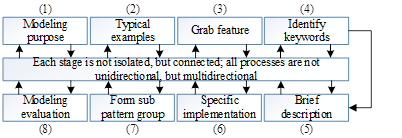
Language communication between two or more parties is called a dialogue; however, not all language communication is a dialogue. In a preschool teacher’s inquiry, the child and the teacher have an equal relationship and engage in “participation and cooperation” when communicating. Between professors and pupils, there are one-way, two-way, three-way, and multiple-way communication channels. The multidirectional connection between teachers and children is the aspect of teacher-student communication that deserves the most appreciation as depicted in Figure 3.

Figure 4 illustrates the two relationships between the various components of the language ability teaching system for kids in an information technology environment: one is a direct relationship, like the one between teachers and students, teaching materials, and educational media; the other is an indirect relationship, like the one between the teaching environment, the language field goal, the language teaching approach, the “discovery” teaching method, and the teaching evaluation.
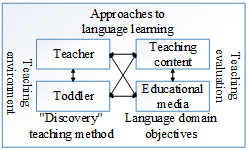
The educational approach of “guidance and inquiry” has many different applications because there are numerous ways to guide and inquire. The author sums up a fundamental model, according to which the core of an information technology environment is “problem situation, teachers, and children,” and the primary line is “problem-guidance-thinking-exploration” (Figure 5).

The kindergarten curriculum is extensive and educational, broadly categorized into five areas: health, language, society, science, and art. These areas can be further segmented, with each content domain interacting with others to nurture children’s emotions, attitudes, talents, knowledge, and skills from various perspectives. Language serves as a tool for self-expression and communication. To investigate a more focused sub-mode of the “Guide-Inquiry” teaching method and enhance teaching effectiveness, the language learning objective is integrated into various kindergarten domains beyond the language field. Consequently, the author provides a brief overview of the training method for children’s language skills in an information technology setting (Figures 6, 7, 8, 9, 10).

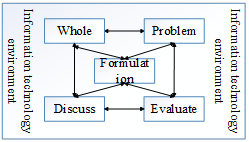

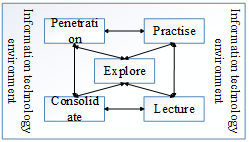
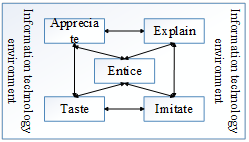
Assuming the original dataset
Randomly divide the original training set
Take
Perform step 2 for
The number of samples of
Process the obtained
If it is a regression problem, average the five prediction results to
obtain
If it is a classification problem, use the five prediction results
for simple voting to obtain
The above process illustrates the training of a learner with a fold
number
Before introducing the weight calculation method, we first define the
indicator function
Assuming that the size of the dataset is
Calculate the error rate of the classifier in
Calculate the ratio of the correct rate to the error rate, and
the calculation formula:
To make the input features of the meta-classifier obey the
probability distribution, a normalization operation is required:
The calculated
A common machine learning approach for completing dichotomous tasks
and for estimating the likelihood of an occurrence is logistic
regression (LR). The sigmoid function is the foundation of logistic
regression. The mathematical formula for it is:
Where
The likelihood function is:
The log-likelihood function is:
The purpose of maximum likelihood estimation is to obtain the value
of parameter
Eq. [eq11] is multiplied by one more negative
coefficient than equation [eq10], so taking the minimum value of the
cost function
After constructing the cost function [eq11], it needs
to be solved using the gradient descent method. The update formula for
the parameter
Here,
Combining with formula [eq7], we can get:
Therefore, formula [eq12] can be converted into:
For each update iteration throughout the training process, the value
of parameter
According to the average score trend for each item shown in Figure 11, the quality scores of the X English teaching activities are concentrated in the range of 3 to 5 points, placing them at a medium level. The trend is slowing down, indicating that the score difference between items is not particularly wide. According to the detailed score table in Table 1, the scores for the seven key items are as follows, ranked from high to low: emotional support, teaching design and organization, children’s performance, classroom culture, teaching process, goals and content, and teaching support. This data reveals that instructors’ emotional attitudes are prominent in these areas. Sensitivity to the needs of young children is of high quality and meets good standards. The mode of the teaching support category, as determined by mode analysis, is 3 points, indicating that the majority of its activities fall below the minimum standard and are of poor quality. The mode of the items related to goals and content, instructional design, and organization is 4 points, placing them at a middle level, while the mode of the items related to other topics is 5 points, signifying an advanced or excellent level.
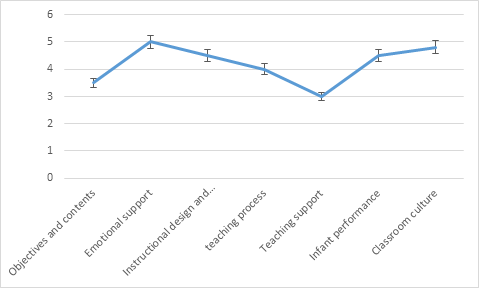
| Project | Minimum value | Maximum | Average | Standard deviation | Mode |
|---|---|---|---|---|---|
| Objectives and contents | 3.00 | 6.00 | 3.8333 | 0.69895 | 4.00 |
| Emotional support | 3.00 | 7.00 | 4.6333 | 1.24524 | 5.00 |
| Instructional design and organization | 2.00 | 6.00 | 4.5000 | 1.04222 | 4.00 |
| Teaching process | 2.00 | 6.00 | 4.3000 | 1.08757 | 5.00 |
| Teaching support | 2.00 | 6.00 | 3.8333 | 1.20585 | 3.00 |
| Infant performance | 3.00 | 6.00 | 4.5000 | 0.90017 | 5.00 |
| Classroom culture | 3.00 | 7.00 | 4.3929 | 1.10016 | 5.00 |
Distribution of the scores for each item is depicted in Figure 12. When examining the standard deviation scores, it is evident that the standard deviation of goals and content is the smallest, indicating a concentrated distribution of scores. Among the 30 actions, 18 received 4 points, and 9 received 3 points, indicating that the objectives and content of X English collective teaching activities are often consistent but only meet the minimum standards for quality. The question measuring emotional support exhibited the highest standard deviation, suggesting a considerable amount of variation in the results. The distribution of scores and the degree of concentration and dispersion for the remaining items are not immediately apparent.
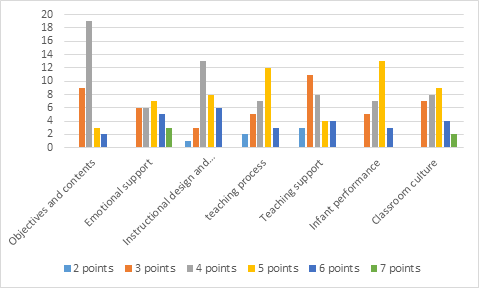
The average scores for high-quality language teaching activities for students of all ages in elementary, middle, and large classes are presented in Table 2 and Figure 13. Large classes outperform in five factors, including classroom culture, instructional assistance, teaching design and organization, emotional support, and objectives and content. Regarding teaching process, children’s performance, and teaching process items, middle classes outperform small and large classes, and small classes overall have lower item scores compared to middle and large classes. Based on the provided scores, only teaching design and organization (4.2 points) achieved the highest score in small classes, reaching just above the minimal standards (3 points). No item received more than 5 points, and four received less than 4 points. In middle class activities, only the objectives and content scores were below 4 points; the other six items all scored higher than 4 points, with teaching process and students’ performance reaching 4.8 points, approaching the standards for good quality. In large class language teaching activities, all scores were higher than 4 points. The emotional support item received the highest score of 5.3 points, surpassing the good quality level. All other item scores were greater than 4 points, resulting in an overall quality level above moderate.

| Objectives and contents | Emotional support | Instructional design and organization | Teaching process | Teaching support | Infant performance | Classroom culture | |
|---|---|---|---|---|---|---|---|
| Small class | 3.7 | 4.1 | 4.2 | 3.5 | 3.2 | 4.0 | 3.9 |
| middle class | 3.6 | 4.5 | 4.6 | 4.8 | 4.0 | 4.8 | 4.3 |
| Taipan | 4.2 | 5.3 | 4.7 | 4.6 | 4.3 | 4.7 | 5.0 |
It revolves around specific subjects and focuses on combining and enhancing language materials that youngsters pick up in their daily lives as a particular language education activity. Language instruction is typically categorized into literary activities, narrative activities, conversation activities, listening and speaking activities, and early reading activities based on the various contents of instructional activities. Table 3 displays the distribution of five activity types among 30 randomly selected language activities. Seventy-six percent of the activities are literary and narrative, with conversation and early reading coming in second and third. There are no group language-learning exercises that involve speaking and listening competitions. According to interviewees, the majority of linguistic activities that teachers comprehend are literary works themselves or refined literary works, such as fairy tales, children’s songs, prose poems, picture narrating, etc.
| Activity type | Literary activities | Tell about activities | Early reading | Conversation activities | Listening and speaking activities |
|---|---|---|---|---|---|
| Number | 12 | 11 | 5 | 2 | 0 |
| Percentage | 40% | 36% | 17% | 7% | 0% |
Table 4 and Figure 14 show that, among the four different categories of language activities, the scores for speaking activities are all higher than 4 points, essentially reaching a good quality level and surpassing other categories. The low and high emotional support scores in four areas of teaching design and organization, teaching support, student performance, and classroom culture suggest that teachers can foster a positive emotional environment for students and encourage them to speak out in conversation activities. However, conversation exercises also place greater demands on teachers’ language teaching techniques, wit in the classroom, feedback, and evaluation, as well as the need to pay special attention to conversational content in activities. This encourages constructive communication between teachers and students while sparking children’s interest in language use.
Literary activities use literary works as a primary source of content and concentrate on how students perceive, comprehend, and express the works themselves. Children’s behavior management, time management, and instructional effectiveness are not well known during activities. As a result, scores for items related to the teaching process are the lowest, while scores for other aspects are moderate. The objectives and content items for early reading exercises receive the lowest scores. The appreciation of literary works is distinct from early reading. The objective is to provide youngsters with rich reading and pre-writing experiences gradually. Although teachers’ objectives may include students learning to read or write, these objectives are frequently confused with the appreciation of literary works throughout activities, making it challenging to accomplish the initial objectives and resulting in a low score.
| Objectives and contents | Emotional support | Instructional design and organization | Teaching process | Teaching support | Infant performance | Classroom culture | |
|---|---|---|---|---|---|---|---|
| Literary activities | 3.8 | 4.8 | 4.4 | 4.1 | 3.7 | 4.5 | 4.4 |
| Tell about activities | 4 | 5 | 5.5 | 4.5 | 5 | 5 | 5.5 |
| Early reading | 3.7 | 4.3 | 4.5 | 4.5 | 3.9 | 4.5 | 4.4 |
| Conversation activities | 4 | 4.8 | 4.4 | 4.2 | 3.6 | 4.4 | 4 |
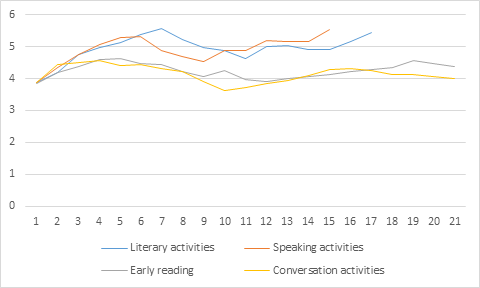
Through on-site observation and recording in conjunction with teachers’ teaching design plans or lesson plans for this teaching activity, the “Target and Content” item primarily assesses the adequacy of objectives and contents set by instructors in teaching activities. Table 5 and Figure 15 present descriptive data indicating that the average quality dimension of the X English teaching activities ranges between 3.27 and 4.87, which is generally low.
| Average | Minimum | Maximum value | Standard deviation | |
|---|---|---|---|---|
| Objectives and contents | 3.8333 | 3.00 | 6.00 | 0.69893 |
| Suitability | 4.7333 | 3.00 | 7.00 | 1.01483 |
| Conformity | 3.2667 | 3.00 | 7.00 | 0.86834 |
| Clarity | 4.8667 | 3.00 | 7.00 | 0.89955 |
| Interest based experience | 4.5333 | 3.00 | 7.00 | 1.13664 |
| Richness and challenge | 3.8000 | 3.00 | 7.00 | 1.12648 |
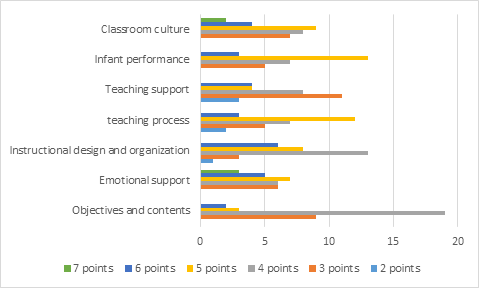
The emotional support item is based on instructors’ sensitivity to children and the emotional climate they generate during instructional activities. X English teaching activities scored highly on this question, with scores largely centered around 5 points, just shy of the passing grade standards. When engaging in instructional activities, teachers take care to create a pleasant and comfortable environment for the students and are quick to identify students’ needs, see Figure 16 and Table 2.
| Emotional support | Emotional atmosphere | Susceptibility | |
|---|---|---|---|
| Average | 4.6333 | 4.7333 | 4.5333 |
| Standard deviation | 1.24522 | 1.36289 | 1.45586 |
| Minimum | 3.00 | 3.00 | 3.00 |
| Maximum value | 7.00 | 7.00 | 7.00 |
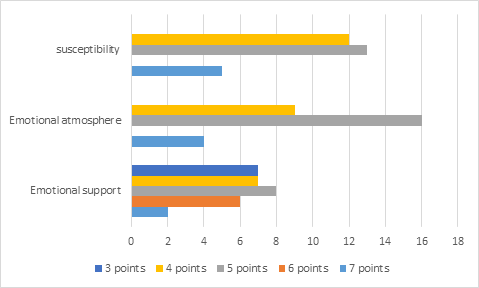
This item’s score falls into the upper-medium range, close to the high-grade level. The teaching organization technique has the maximum score, and the lowest value is 5. However, there is a circumstance when the value of 1 is improper, showing that there are still some issues with the availability and use of tools and materials in X kindergarten during group teaching activities [28]. The degree of data dispersion is relatively high, the difference between activities is significant, and the scores for teaching preparation and process design are highly concentrated at 5 points, see Figure 17 and Table 7.
| Instructional design and organization | Teaching preparation | Process design | Teaching organization | Application of teaching equipment and materials | |
|---|---|---|---|---|---|
| Average | 4.5000 | 4.8667 | 4.4667 | 5.5333 | 4.1538 |
| Standard deviation | 1.04221 | 1.16658 | 1.16658 | 1.89955 | 1.40548 |
| Minimum | 2.00 | 3.00 | 3.00 | 5.00 | 1.00 |
| Maximum value | 6.00 | 7.00 | 7.00 | 7.00 | 7.00 |
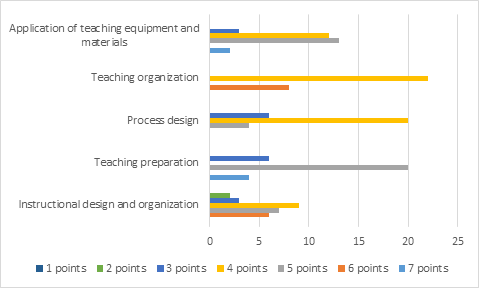
All of the ratings for this item are higher than 4 points, suggesting an upper-medium level of quality. Only in terms of duration is it unacceptable to give the lowest score. The total score is centered at 5 points, suggesting that X English teaching activities, teachers can apply specific tactics to manage children’s behavior in the teaching process, deal with unforeseen occurrences effectively, and can grasp the overall time and efficiency of activities, see Figure 18 and Table 8.
| Teaching process | Child behavior management | Handling of unexpected events | Opportunities offered | Length of time | Teaching process and efficiency | |
|---|---|---|---|---|---|---|
| Average | 4.3000 | 4.8000 | 4.2945 | 4.9335 | 4.2669 | 4.8000 |
| Standard deviation | 1.08757 | 1.21488 | 1.21265 | 1.22993 | 1.22993 | 1.32355 |
| Minimum | 2.00 | 3.00 | 3.00 | 3.00 | 1.00 | 3.00 |
| Maximum value | 6.00 | 7.00 | 7.00 | 7.00 | 7.00 | 7.00 |
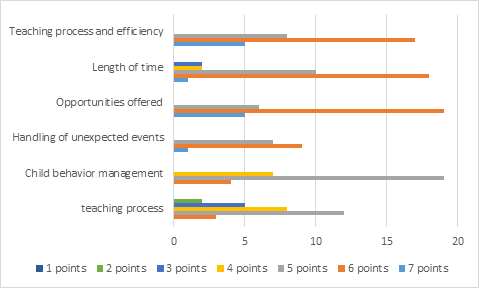
No matter the project or dimension, the teaching support score is generally low, concentrated in 3 points, and only meets the minimum required standard. Additionally, the teaching method and teaching wit have an inappropriate 1-point situation, demonstrating that X kindergarten is in the language teaching field [26, 27]. The teaching skills of active teachers still need to be developed, and emphasis should be placed on the organic combination of teaching strategies as well as the adaptability of teaching from young children’s immediate responses, see Figure 19 and Table 9.
| Teaching support | Language mode | Teaching method | Teaching wit | Thinking skills development | Feedback and evaluation | |
|---|---|---|---|---|---|---|
| Average | 3.8333 | 4.9333 | 3.6000 | 3.8667 | 4.4000 | 4.6000 |
| Standard deviation | 1.20583 | 1.43679 | 1.19195 | 1.35784 | 1.40444 | 1.22053 |
| Minimum | 2.00 | 3.00 | 1.00 | 1.00 | 3.00 | 3.00 |
| Maximum value | 6.00 | 7.00 | 5.00 | 7.00 | 7.00 | 7.00 |
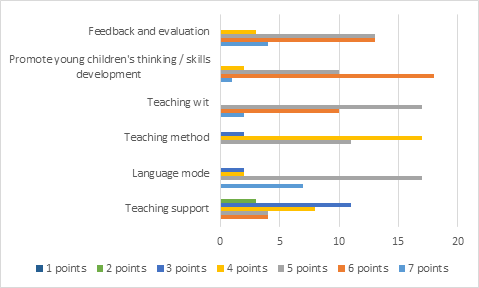
It is determined that the quality of language teaching activities in kindergartens is at a middle level through sampling observation of these activities and using the sub-scale “group teaching” of the “Education Quality Evaluation Scale for Kindergarten Institutions in China” (trial version) to conduct evaluation and analysis. Level. The following findings are reached from an analysis of the entire project:
In seven major projects, the level of objectives, content, and teaching support is generally low, the teaching process and classroom culture are generally in the middle, the activities are dispersed, the quality gap is significant, and the performance of the students is generally upper-middle level.
The quality of the activity can be more significantly influenced by the teacher’s work experience as shown by their age, professional title, and teaching age, as well as by the year in which they began their teaching career.
Compared to middle- and large-sized classrooms, the quality level of language teaching activities in small classes is marginally lower.
Literature activities make up the majority of the language teaching activities in Kindergarten X that were observed; no teaching was. The quality of narration activities is the highest among the four language kinds in terms of hearing and speaking activities, and it has reached a satisfactory level. Early reading and discussion activities had slightly poorer quality scores despite literary activities.
The experimental data used to support the findings of this study are available from the corresponding author upon request.
The author declares no conflicts of interest regarding this work.
This work was supported by Anhui Hanxiang International Freight Forwarding Company Limited International Business Negotiation Project Entrustment Agreement
1970-2025 CP (Manitoba, Canada) unless otherwise stated.